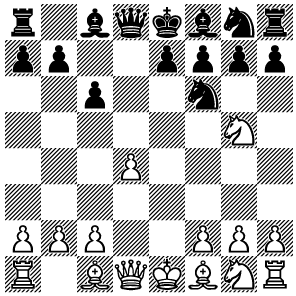Book Reviews by Sam Collins
 Today I would like to look at one of the latest offerings from Everyman Chess — Main Line Caro-Kann (143 pages, RRP £14.99) by GM Neil McDonald. This is an attractive effort dealing with everything after 1 e4 c6 2 d4 d5 3 Nc3 dxe4 4 Nxe4. McDonald hopes that it is “a useful snapshot of the state of theory in the main line Caro-Kann”, and I believe that the book fully serves this purpose. Today I would like to look at one of the latest offerings from Everyman Chess — Main Line Caro-Kann (143 pages, RRP £14.99) by GM Neil McDonald. This is an attractive effort dealing with everything after 1 e4 c6 2 d4 d5 3 Nc3 dxe4 4 Nxe4. McDonald hopes that it is “a useful snapshot of the state of theory in the main line Caro-Kann”, and I believe that the book fully serves this purpose.
It is important to note that this is not a repertoire book, and is not written exclusively for Black or White. A repertoire book offers certain advantages to the reader, namely a more thorough coverage of recommended lines (since the author doesn’t have to deal with every variation, only the best lines for a particular colour) and the decision is made for the reader concerning which lines to play. The advantages offered by a book like Main Line Caro-Kann, however, are that the reader is offered greater flexibility in his choice of lines, and the book is equally useful to players of both colours. I suppose it’s merely a matter of taste as to which type you prefer.
The book consists of eight chapters dealing with the theory of the Smyslov System (4...Nd7), Classical System (4...Bf5), and systems beginning with 4...Nf6. The material is laid out in 49 complete games, including many games played in 2000.
McDonald opens with an excellent introduction, describing the importance of the four central squares in the Caro-Kann: “The secret of playing the Caro-Kann well is knowing when it is appropriate to loosen your influence over one of the central squares in order to increase your control of another, more important square”. The examples given in the introduction help the reader to understand much of the material presented later in the book. McDonald also touches on endgame structures before moving on to the complete games.
Each chapter has its own brief introduction and summary, where McDonald outlines his recommendations for both White and Black. The games themselves are well-annotated, with a nice blend of verbal explanation and concrete variations. Most of the variations, however, are from other games played from the same position; McDonald doesn’t include a lot of independent analysis, as far as I can see.
Here is a typical example of what the reader can expect to find in this book, namely good analysis with strong verbal explanation:
1 e4 c6 2 d4 d5 3 Nc3 dxe4 4 Nxe4 Nd7 5 Ng5 Ndf6

6 Bc4
“For a long time it was thought that Black’s last move was poor against 5 Ng5 (though satisfactory against 5 Bc4 Ndf6 6 Ng5, transposing to the present game) as white can play 6 N1f3 when Black has no time to evict the knight from g5, for if 6...h6? 7 Nxf7! Kxf7 8 Ne5+ Ke8 9 Bd3 and the check on g6 will win the game for White. So in Nunn-Tal, Brussels 1988, Black tried 6...e6 but he was soon in trouble: 7 Ne5! Nh6 8 Bd3 Bd6 (not 8...Qxd4 9 Ngxf7! Nxf7 10 Nxf7 Bb4+ 11 c3) 9 c3 Qc7 10 Qe2 c5 (after 10...0-0 11 Ngf3 Nf5 12 g4 and Black is facing a huge attack) 11 Bb5+ Ke7 12 0-0 cxd4 (if he plays passively White can attack with 13 f4 etc.) 13 cxd4 Nf5 14 Be3! and Black was unable to withstand White’s attack and lost in six more moves.
However, one good feature of 5...Ndf6 is that the diagonal of the queen’s bishop has already been opened. Therefore 6...Bg4!? is a logical response. After 7 Be2 Bxf3 8 Nxf3 e6 9 0-0 Bd6 10 Re1 Ne7 11 Bd3 0-0, as in Adams-Seirawan, Bermuda (7th match game) 2000, White enjoys the two bishops and a little more space, but Black has an exceptionally solid structure and all of his minor pieces are on useful squares. The game continued 12 Bg5 Qc7! 13 g3 (preventing 13...Bf4) 13...c5 14 c3 Rad8 15 Qc2 h6 16 Bxf6 gxf6 (Black’s kingside is fractured, but every important square is well protected) 17 Qd2 Kg7 18 Rad1 cxd4 19 Nxd4 Bc5 20 Nf3 Ng6 21 Qe2 f5 and after a few more moves a draw was agreed.”
All in all, a good book from a reliable GM author.
My Assessment (with 5 stars being the highest mark): * * * *
Other reviews by Sam Collins
Review 1: Play the Open Games as Black, by John Emms
Review 2: The Human Comedy of Chess: A Grandmaster’s Chronicles by GM Hans Ree & Storming the Barricades by GM Larry Christiansen
Review 3: Open Ruy Lopez by Glenn Flear
Review 4: Main Line Caro-Kann by Neil McDonald
Review 5: Offbeat Spanish by Glenn Flear
Review 6: Excelling at Chess by Jacob Aagard
Review 7: Can You Be a Positional Chess Genius? by Angus Dunnington
Review 8: The Grunfeld Defence by Nigel Davies
Review 9: The Best of Chess Cafe
Review 10: How To Build Your Chess Opening Repertoire by Steve Giddins
Review 11: The …a6 Slav by Glenn Flear
Review 12: Starting Out: The Ruy Lopez by John Shaw
Review 13: Knockout Nimzo (video) by Tony Kosten
Review 14: My Great Predecessors by Gary Kasparov
|


